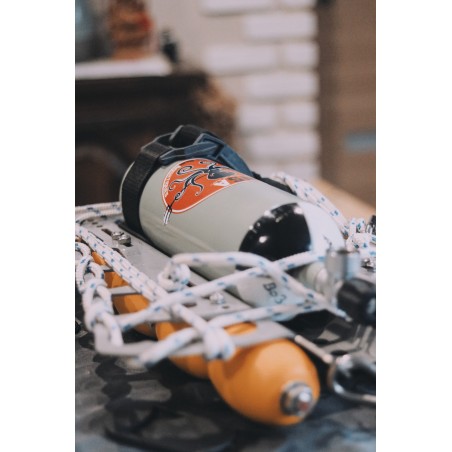The waste lift cannot operate without a lifting parachute. It has been developed to lift a multitude of small loads (such as bags of waste). A parachute is therefore fitted to the frame of the lift to fill it with air and lift everything up. The advantage of the waste lift is that it can carry its own air supply (standard tank of 1-7L). It can therefore go back and forth between the seabed and the surface without depleting the divers' air supply.
You will also need the following equipment (sold separately):
Scuba tank
x1
REQUIRED | Standard scuba tank from 1L to 7L. Manta Innovation recommends a 3L tank preferably aluminium rather than stainless steel to make the structure lighter. |
Lifting parachute
x1
REQUIRED | Lifting parachute from 30L to 50L. The parachute must be equipped with a system that does not allow air to escape (duckbill type or pressure valve), so that once it reaches the surface, air does not escape it does not empty and the lift does not fall back down. |
1st stage complete
x1
REQUIRED | 1st stage. In the case of a duckbill parachute, choose a 1st stage with a regulator. In the case of a parachute with a pressure valve, a 1st stage with a direct system hose is preferable. In any case, the air flow must be quick and unobstructed. |
Spool (or Ariadne’s thread)
x1
OPTIONAL | Spool. The waste lift can be used at depths of up to 40 m in extremis (20 m in normal use). Always use a spool that is longer than the diving depth. |
Flasher (light beacon)
x1
OPTIONAL | Standard flasher. To locate the lift underwater as well as on the surface, it can be useful to attach a flasher to the waste lift, for example by using a piece of string. |
Collection bags
x16 max
REQUIRED | Waste collection bag. Manta Innovation recommends the BELUBAG, a bag designed to collect waste underwater, which can be attached to the lift with carabiners. However, the lift is designed to accommodate any other bag (via carabiners). |
Carabiners
x16 max
REQUIRED | 8 mm or 10 mm carabiners, stainless steel or aluminium. Take as many carabiners as there are collection bags, with up to a maximum of 16 bags/carabiners. |


 Cart
Cart






